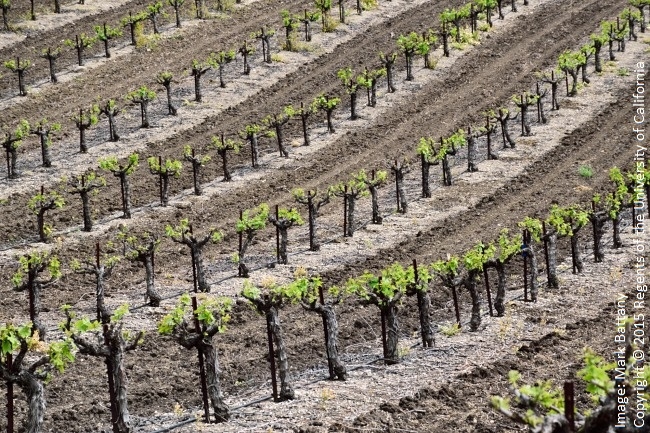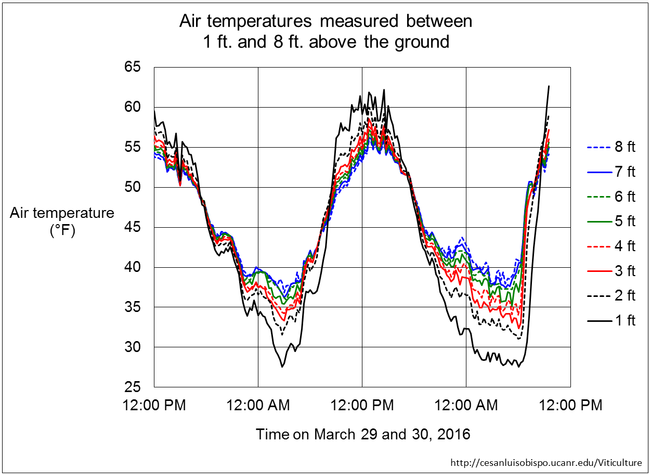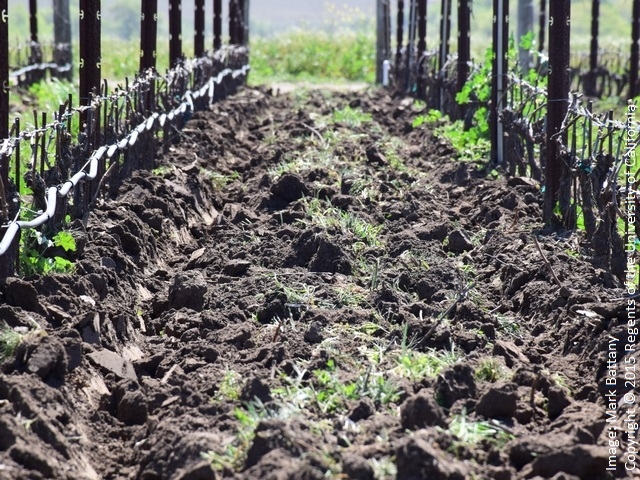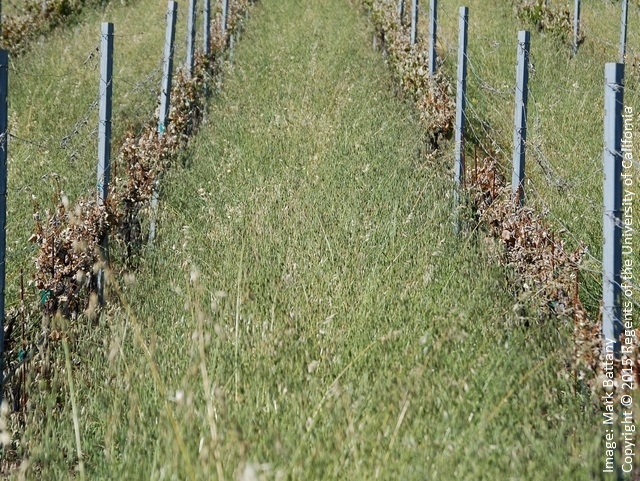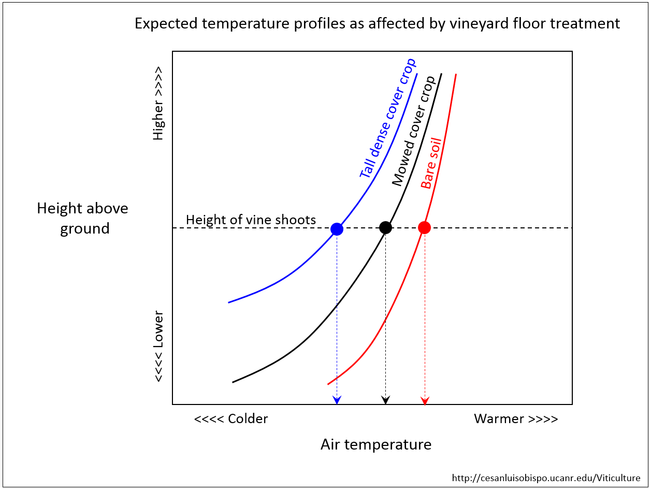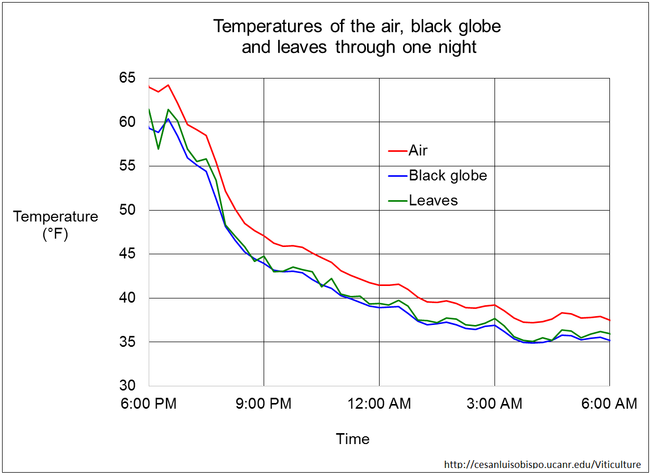The isolated frosts last week are a reminder that frost can inflict significant damage to vineyards that are not adequately protected. Growers who do not have active protection measures such as sprinklers or wind machines will need to rely instead upon passive protection measures, otherwise they risk having potentially avoidable frost damage. The timely implementation of these passive measures can create significantly warmer temperatures within the vineyard on cold nights, and ultimately lead to much less frost damage. For some sites the use of appropriate passive protection measures may provide sufficient protection such that more expensive active measures will not be necessary.
The management of the vineyard floor is the main passive measure that growers can use at this time to influence frost risk in their existing vineyards. Other passive measures like appropriate site selection, variety selection, vine training height, etc. were set earlier during the vineyard design phase. The condition of the vineyard floor will have a significant impact on the temperatures experienced by the sensitive vine tissues during frost risk periods, and thus should be managed during the frost risk period with this in mind. To better understand the outcomes of different floor management practices, it is important to appreciate how the air temperature is impacted by the ground surface condition.
Solar radiation during the daytime heats the ground surface and some of this heat is conducted and stored in the soil. This stored heat is then released at night as it is conducted back out of the soil. An actively growing cover crop or residues on the soil acts as a reflecting and insulating layer, and therefore reduces the amount of heat that is conducted into the soil during the daytime and also reduces the amount that is emitted at night. This results in significantly colder air temperatures at a site with a cover crop or thick residue layer as compared to the same site having exposed bare soil. The greatest warming effect occurs when the bare soil is dark, moist, and well-settled as it then provides maximum absorbance, conductance and storage of heat during the daytime, and subsequent release of that heat at night.
At nighttime under conditions of clear skies and no wind, the coldest air temperatures occur closest to the surface and tend to increase with height above the ground. This is particularly the case on radiation frost nights, when air temperatures can be strongly stratified. Following some preliminary measurements of these temperature stratification profiles in 2012, they have been studied in more detail at multiple locations on the Central Coast. Figure 2 below shows an example of the substantial temperature stratification observed during the two cold nights last week.
Under such stratified air temperature conditions vines trained lower to the ground are more prone to experience colder temperatures. This factor needs to be kept in mind as it is becoming fairly common in some areas for growers to train the vines to very low heights, and in so doing the frost-prone tissues are often less than two feet above the ground surface. These low-trained vines are even more likely to suffer from frost if the cover crops are present during the frost risk period.
A similar increase in frost risk occurs with vines trained at conventional heights, if the cover crop is allowed to grow very tall and dense. The result of this tall growth is to shift the coldest air temperatures higher up towards the frost-sensitive vine tissues, because the coldest air temperatures occur at the top portion of the cover crop canopy. Figure 4 below shows an example of a site where the cover crop was allowed to grow very tall over the entire vineyard floor, which contributed to the frost damage at this site.
The general pattern of how air temperatures will be influenced by different vineyard floor management conditions under radiation frost conditions is shown in Figure 4 below. The bare soil (red line) has the warmest air temperatures, a mowed cover crop has intermediate temperatures, and a tall dense cover crop has the coldest air temperatures for a given height where frost-sensitive vine tissues are located. As the vine height becomes shorter, the air temperature experienced by the vine tissues would be lower under all vineyard floor treatments under typical radiation frost conditions.
Thus we can predict that the coldest air temperatures will be experienced by very short vines in vineyards with tall, dense cover crops. This situation can occur with second year vines that have been pruned back down to short spurs near the ground and which do not have grow tubes for protection (Figure 6 below).
Growers who are farming steeper slopes prone to erosion may hesitate to till under cover crops due to concerns about runoff and erosion damage from spring rainstorms. Fortunately the frost risk is lower at such sites if air drainage is adequate, and therefore growers may find that having mowed or low-growing cover crops bring little additional frost risk at such sites. Vineyards in the lower flatter areas where frost risk is greater will have less risk of erosion from rainstorms, and can be tilled or closely mowed more safely.
When discussing air temperatures under frost conditions, it is important to understand that the actual temperature of the vine tissues (and other objects) that are directly exposed to the nighttime sky are often considerably colder than the air temperatures that we normally measure with our weather stations. And just how much colder the vine tissues are than the air temperature will vary; generally the clearer the nighttime sky, the colder the exposed vine tissues will be relative to the air temperature. By convention, we measure air temperature with sensors that are located inside white vented shields, called radiation shields. If we want to better quantify frost risk conditions, we might find it advantageous to use sensors that more closely mimic tissue temperatures. One such sensor is available commercially.
An alternative sensor has recently been tested for this same use, called the "black globe." This consists of a 6" diameter hollow copper sphere with a temperature sensor inside, painted flat black (Figure 7). Local testing in the fall of 2014 indicated that this sensor mimicked grape leaf temperatures at night very closely (Figure 8). The advantage of using this black globe sensor is that it can also be used during the daytime to measure a useful heat stress index for people who are physically active outdoors (called the wet-bulb globe temperature or WBGT index). This index is widely used by the US military as well as industry and sports teams because it can predict how weather conditions will impact human and animal heat stress levels and hence safety when outdoors. This dual benefit from a single sensor could make this a very useful addition to many weather stations in the future to improve information on frost conditions while also providing an added benefit of enhancing worker safety.
For more detailed information on a range of frost protection topics, see the UCCE San Luis Obispo website.
